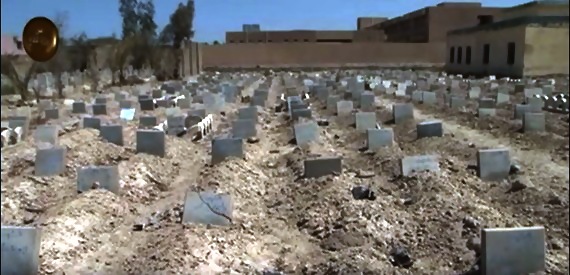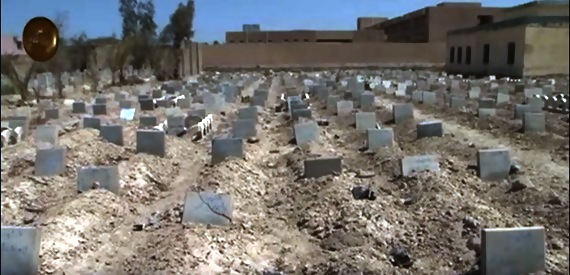By Mustafa Sadoun | Fallujah | ( Niqash.org) | – –
NIQASH visits an ISIL cemetery in Fallujah and finds the hastily built, last resting places of several of the group’s leaders, as well as unusual ideas for what to do with the place in the long run.

A still from the Iraqi military’s video of the tour of Fallujah, showing the IS cemetery with 500 graves.
Since they managed to push the [so-called] Islamic State [group] out of Fallujah in June, the Iraqi military has been discovering exactly how the extremist group ran the city. At the beginning of September, they announced that they had discovered a special cemetery that the . . . IS, group had built behind the walls of an abandoned school.
The cemetery had 500 numbered graves, from one to 500. Names of the dead were inscribed on the gravestones, as well as the date of their death. A closer look showed that most of those buried here had been killed over the past four months. Additionally, the cemetery was quite possibly also the final resting place for several of the extremist group’s leaders. Many of those in the extremist group share similar names. But the cemetery includes one Abu Talha al-Muhajer, quite likely originally from Germany who was a senior commander in the IS group in Anbar. There is also a Abu Qatada al-Libi, probably originally from Libya who commanded the IS group in Salahaddin province and Abu Anas, from Syria, deputy commander of the extremist group in Baghdad.
This cemetery could provide information of historical importance to future Iraqi generations.
“The IS group used to believe that it would stay in control of Fallujah forever,” Lieutenant General Abdel Wahab al-Saadi, the commander of operations in Fallujah, told NIQASH. “That’s why they built cemeteries and Islamic courts. But in the end they lost everything and this cemetery is a symbol of that, a witness to their losses and the victory of the Iraqi forces. It shows that we are able to end this terrorism.”
The later graves, numbered 250 to 500, appeared to have been dug only a few days before Iraq’s pro-government forces started battling for the city. The graves numbered one to 250 were older and often those buried there had died elsewhere and had been brought to Fallujah for burial.
Roaming around the cemetery it is quite clear that the later graves were dug in a hurry. Names of the dead have been misspelled and dates are odd.
“A large number of those buried here are foreigners too,” Brigadier General Yahya Rasoul, the spokesperson for the Iraqi forces here, said. “I’d say more than 80 percent. They wanted Iraq to deteriorate and they obviously thought they would be here to stay.”
The Iraqi military’s video of the tour of Fallujah’s IS sites, which also includes the interior of an IS court and a prison.
A local man was nearby during the trip for local media organized by the Iraqi military. He told NIQASH that there were other graves in the city too but that it was difficult to find them. It is also likely that other cemeteries contain bodies of civilians the IS group executed and members of pro-government forces they killed.
“As the fighting intensified, the IS group were forced to dig new graves and that’s what happened here,” he said, requesting anonymity for security reasons.
Salama al-Khafaji, of the Iraq High Commission for Human Rights, believes the IS group’s Fallujah cemetery should be preserved as “a memorial to the heroic victory by our armed forces”.
“The information on the gravestones, like the names of the dead and the dates and their nationalities, are also important,” al-Khafaji said. “For researchers studying the IS group, and how its influence expanded, they could study these cemeteries in Fallujah and in Khalidiyah and construct a map of the world to show how far the IS group’s influence extended. This cemetery could provide information of historical importance to future Iraqi generations.”
Right now al-Khafaji’s plans seem unlikely to be realized. It is more likely that the government would remove the bodies and level the cemetery so that the school buildings can be returned to use for the students, who may never know the gruesome use their playground was put to.



 © 2025 All Rights Reserved
© 2025 All Rights Reserved